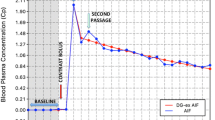Abstract
Objective
To deepen understanding of hemodynamics in the femoral head, i.e., the essential factor in clarifying pathogenesis of hip disorders, this study examined blood flow and blood volume in the femoral heads of healthy adults, and their changes with age, by using positron emission tomography (PET).
Methods
In 16 healthy adult males (age: 20–78 years old, mean age: 42 years), blood flow was measured by means of the H2 15O dynamic study method, and blood volume was measured by means of the15O-labeled carbon monoxide bolus inhalations methods.
Results
Blood flow was 1.68–6.47 ml/min/100g (mean±SD: 3.52±1.2), and blood volume was 1.67–6.03 ml/100 g (mean±SD: 3.00±1.27). Blood flow significantly decreased (p<0.01) with age, and blood volume significantly increased (p<0.05).
Conclusion
PET was useful in the measurement of blood flow and blood volume in the femoral heads. With age, physiological hemodynamic changes also increased in femoral heads.
Similar content being viewed by others
References
Cumming JD. A study of blood flow through bone marrow by a method of venous effluent collection.J Physiol 1962; 162: 13–20.
Kelly PJ, Yipintsoi T, Bassingthwaighte JB. Blood flow in canine tibial diaphysis estimated by iodoantipyrine-125I washout.J Appl Physiol 1971; 31: 38–47.
MacPherson JN, Tothill P. Bone blood flow and age in the rat.Clinical Science and Molecular Medicine 1978; 54: 111–113.
McPherson A, Scales JT, Gordon LH. A method of estimating qualitative changes of blood-flow in bone.J Bone Joint Surg BR 1961; 43B: 791–799.
Morris MA, Kelly PJ. Use of tracer microspheres to measure bone blood flow in conscious dog.Calcif Tissue Int 1980; 32: 69–76.
Paradis GR, Kelly PJ. Blood flow and mineral deposition in canine tibial fratures.J Bone Joint Surg AM 1975; 57A: 220–226.
Whiteside LA, Lesker PA, Simmons DJ. Measurement of regional bone and bone marrow blood flow in the rabbit using the hydrogen washout techniquesClin Orthop 1977; 122: 340–346.
Ashcroft GP, Evans NTS, Roeda D, Dodd M, Mallard JR, Porter RW, et al. Measurement of blood flow in tibial fracture patients using positron emission tomography.J Bone Joint Surg BR 1992; 74B: 673–677.
Martiat PH, Ferrant A, Cogneau M, Bol A, Michel C, Rodhain J, et al. Assessment of bone marrow blood flow using positron emission tomography: no relationship with bone marrow celluarity.Brit J Haematol 1987; 66: 307–310.
Kahn D, Weiner GJ, Ben-Haim S, Boles Ponto LL, Madsen MT, Bushnell DL, et al. Positron emission tomographic measurement of bone marrow blood flow to the pelvis and lumbar vertebrae in young normal adults.Blood 1994; 83: 958–963.
Ketty SS. The theory and applications of the exchange of inert gas at the lungs and tissuesPharmacol Rev 1951; 3: 1–41.
Phelps ME, Huang S-C, Hoffman EJ, Kuhl DE. Validation of tomographic measurement of cerebral blood volume with C-11 labeled carboxyhemoglobin.J Nucl Med 1979; 20: 328–334.
Hino A, Ueda S, Mizukawa N, Imahori Y, Tenjin H. Effect of hemodilution on cerebral hemodynamics and oxygen metabolism.Stroke 1992; 23: 423–426.
Guyton AC. Textbook of medical physiology. Philadelphia; WB Saunderes, 1991: 186.
Kubo T, Yamazoe S, Sugano N, Fujioka M, Naruse S, Yoshimura N, et al. Initial MRI findings of non-traumatic osteonecrosis of the femoral head in renal allograft recipients.Magnetic Resonance Imaging 1997; 15: 1017–1023.
Aaron RK. Osteonecrosis: Etiology, pathophysiology, and diagnosis. In: Callaghan JJ, Rosenberg AG, Rubash HE, editors.The Adult Hip, vol. 1. Philadelphia, Lippincott-Raven, 1998: 451–466.
Author information
Authors and Affiliations
Corresponding author
Rights and permissions
About this article
Cite this article
Kubo, T., Kimori, K., Nakamura, F. et al. Blood flow and blood volume in the femoral head of healthy adults according to age: Measurement with positron emission tomography (PET). Ann Nucl Med 15, 231–235 (2001). https://doi.org/10.1007/BF02987837
Received:
Accepted:
Issue Date:
DOI: https://doi.org/10.1007/BF02987837




